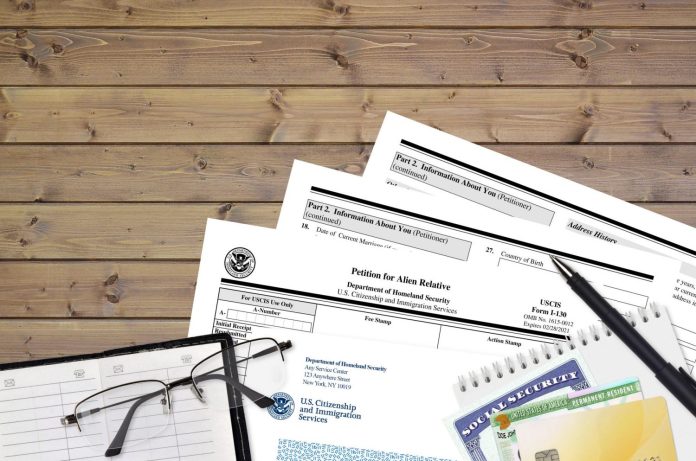What is Form I-130?
Form I-130, officially titled the “Petition for Alien Relative,” is a form used by United States citizens and lawful permanent residents (green card holders) to petition the U.S. government for permission to bring certain eligible family members to the United States as immigrants or to help them adjust their status if they are already in the country. This form is the first step in the process of obtaining a family-based immigrant visa or green card for a family member.
Key points about Form I-130:
- Purpose: The primary purpose of Form I-130 is to establish a qualifying family relationship between the petitioner (the U.S. citizen or green card holder) and the beneficiary (the family member seeking immigration benefits). The form is used to prove that a legitimate family relationship exists and that the petitioner is eligible to sponsor the beneficiary.
- Eligible Relatives: U.S. citizens can use Form I-130 to petition for their spouses, children (both unmarried and married), parents, and siblings. Green card holders can use it to petition for their spouses and unmarried children.
- Submission: The completed Form I-130, along with all required supporting documents and the appropriate filing fee, is typically submitted to U.S. Citizenship and Immigration Services (USCIS), which is part of the Department of Homeland Security (DHS).
- Processing Times: The processing time for Form I-130 can vary significantly depending on factors such as the petitioner’s relationship to the beneficiary, the beneficiary’s country of residence, and USCIS workload. USCIS may require additional evidence or documentation to establish the authenticity of the family relationship.
- Approval: If USCIS approves Form I-130, it means that they have recognized the family relationship as valid. After approval, the case may proceed to the next steps in the immigration process, such as visa processing at a U.S. embassy or consulate (if the beneficiary is outside the U.S.) or adjustment of status (if the beneficiary is already in the U.S.).
- Conditional Residents: In some cases, if the beneficiary is a spouse, they may initially receive conditional permanent resident status. This means they will need to file a petition to remove the conditions on their permanent residency after a certain period.
How to fill out Form I-130?
Filling out Form I-130, Petition for Alien Relative, correctly is crucial to the immigration process. Here are step-by-step instructions on how to fill out Form I-130:
- Download the Form: You can download Form I-130 from the official U.S. Citizenship and Immigration Services (USCIS) website.
- Read the Instructions: Before you begin, carefully read the instructions that accompany the form. The instructions provide important information about who can file the form, filing fees, supporting documents, and where to mail the completed form.
- Select the Appropriate Category: Determine the category under which you are filing the I-130 petition. This will depend on your relationship with the beneficiary (the family member you’re sponsoring). Common categories include “Immediate Relative of a U.S. Citizen” and “Preference Category.”
- Complete Part 1: Information About You (the Petitioner): Provide your personal information, including your full name, address, date of birth, and contact information. If you have previously filed a petition for the same beneficiary, include that information as well.
- Complete Part 2: Information About Your Beneficiary: Provide information about the beneficiary, including their full name, address, date of birth, and relationship to you. Specify the beneficiary’s gender and marital status.
- Complete Part 3: Additional Information About You (the Petitioner): Answer the questions in this section about your citizenship or immigration status, marital history, and previous visa petitions.
- Complete Part 4: Information About Your Family: List your other family members, including your spouse and any children, even if they are not beneficiaries in this petition.
- Complete Part 5: Information About Your Previous Petitions: If you have previously filed petitions for other family members, provide details in this section.
- Complete Part 6: Statement About Your Sponsorship: Sign and date this section to certify that you understand your obligations as the sponsor.
- Complete Part 7: Contact Information, Declaration, and Signature of the Person Preparing this Petition: If you prepared the form yourself, sign and date this section. If someone else prepared it for you, they should sign and provide their contact information.
- Complete Part 8: Signature of the Person Requesting an Interpreter: If you need an interpreter to help you complete the form, the interpreter should sign this section.
- Complete Part 9: Signature of the Person Preparing the Form, If Other Than the Petitioner: If someone else prepared the form for you, they should sign and date this section.
- Supporting Documents: Include all required supporting documents, such as proof of your U.S. citizenship or lawful permanent resident status, proof of the qualifying relationship, and any other documents specific to your case. Refer to the form instructions for a list of required documents.
- Filing Fee: Include the appropriate filing fee with your application. Check the USCIS website or the form instructions for the current fee amount and acceptable payment methods.
- Mail Your Application: Carefully review the form and all supporting documents to ensure accuracy. Make copies of everything for your records. Mail the completed application to the address specified in the form instructions, along with the required fee.
- Check Your Case Status: After submitting your Form I-130, you can check the status of your case on the USCIS website using the receipt number provided on your receipt notice.
Form I-130 checklist of required documents
Form I-130, Petition for Alien Relative, is a document used by U.S. citizens and lawful permanent residents (green card holders) to sponsor certain eligible family members for immigration to the United States. When submitting Form I-130, you should include a checklist of required documents to support your petition. Here’s a Form I-130 checklist of required documents:
- Form I-130: Make sure the form is completed accurately and signed by the petitioner (U.S. citizen or green card holder).
- Filing Fee: Include the appropriate filing fee, which can change over time. Check the USCIS website or the current form instructions for the latest fee information.
- Proof of Petitioner’s Status: Include evidence of your status as a U.S. citizen or green card holder. For U.S. citizens, this could be a copy of your birth certificate, passport, or naturalization certificate. For green card holders, include a copy of your green card.
- Proof of Relationship: Include documents that establish the qualifying relationship between the petitioner and the beneficiary (the family member you’re sponsoring). This can include marriage certificates, birth certificates, or adoption documents, depending on the relationship.
- Beneficiary’s Passport: Include a copy of the beneficiary’s passport biographical page.
- Beneficiary’s Immigration Status: If the beneficiary is already in the United States, provide evidence of their current immigration status, such as a copy of their I-94 record or visa.
- Photographs: Include passport-style photos of both the petitioner and the beneficiary. Follow the specific photo requirements outlined in the form instructions.
- Affidavit of Support (Form I-864): If you are the petitioner and you are sponsoring an immediate relative, such as a spouse or child, you may need to submit an Affidavit of Support (Form I-864) to demonstrate your financial ability to support the beneficiary.
- Supporting Financial Documents: If you are required to submit Form I-864, include supporting financial documents such as tax returns, W-2 forms, and proof of income, as outlined in the I-864 instructions.
- Any Additional Supporting Documents: Depending on the specifics of your case, USCIS may request additional supporting documents. Review the current form instructions and USCIS website for guidance.
- G-1145, E-Notification of Application/Petition Acceptance (optional): Include this form if you want to receive electronic notifications about your case’s status.
- Form G-28 (if applicable): If you have an attorney representing you, include Form G-28, Notice of Entry of Appearance as Attorney.



